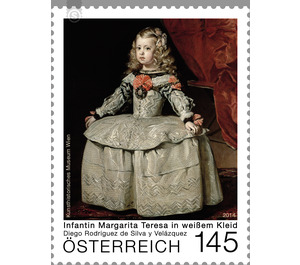Old Masters - Austria / II. Republic of Austria 2014 - 145 Euro Cent
Theme: Art & Culture
| Country | Austria / II. Republic of Austria |
| Issue Date | 2014 |
| Face Value | 145.00 |
| Edition Issued | 220,000 |
| Printing Type | Combination printing, offset stitch (Etch-Art by OeSD) |
| Stamp Type | Commemorative |
| Item Type | Stamp |
| Chronological Issue Number | 2503 |
| Chronological Chapter | OOS-OE2 |
| SID | 861216 |
| In 63 Wishlists | |
There was a big burden on this five-year-old blond-curled girl - like her heavy dress. One can literally see from the big, serious eyes that the Infanta Margarita Teresa of Spain became a political instrument. Diego Rodriguez de Silva y Velázquez, the famous Baroque portrait painter, who lived from 1599 to 1660 and worked at the court of Philip IV of Spain, created three paintings of the princess, who by marriage to their uncle, who was also their cousin, the Consolidate ties between the Austrian and Spanish lines of the Habsburgs and should refrain from any succession claims of non-Habsburg families. The House of Habsburg has always been known for its talent for securing or extending power through weddings. "Wars may lead others, you, happy Austria, marry," was the guiding principle. Margarita Teresa was thus promised early to the future Emperor Leopold I. The paintings of Velázquez were sent to him, so that he could get a picture of the development of his bride. Portraits of upcoming weddings were very common at the time. Therefore, there are many child portraits of famous artists, the rulers wanted to know their descendants as artistically as possible and portrayed in the most magnificent robes. Margarita Teresa was born in 1651 and was the eyeball of her father Philip IV of Spain. She was called "my joy" by her father. His first marriage had produced no heir apparent, which is why he married his niece Maria Anna, a 30 years younger Austrian Archduchess. From the close kinship children blessings were hoped for - the result of such inbreeding were in truth but sickly offspring. Margarita Teresa's siblings all died in childhood, except for Karl, who had hope for the world empire. In 1666, Margarita Teresa married her uncle, whom she continued to call her, and who since 1658 was emperor of Austria. The motif of this stamp, the painting "Infanta Margarita Teresa in white dress", was created around 1656, when Margarita Teresa was five years old. It belongs to the picture gallery of the Kunsthistorisches Museum. In addition, Velázquez created portraits of her in pink and blue dress and the famous family portrait "Las Meninas", one of the highlights of the Museo del Prado in Madrid. The white dress on the portrait of the Infanta is horizontal and decorated with red rosettes and black lace, her hair is tied with a bow, her hands are gracefully on the dress. Margarita Teresa was a tender creature. After the wedding at the age of 15, she gave birth to six children, of whom only the daughter Maria Antonie was to reach adulthood. The many pregnancies may have so weakened Margarita Teresa that she died at the age of just 21 years. The Infanta was buried in the Capuchin Crypt.


